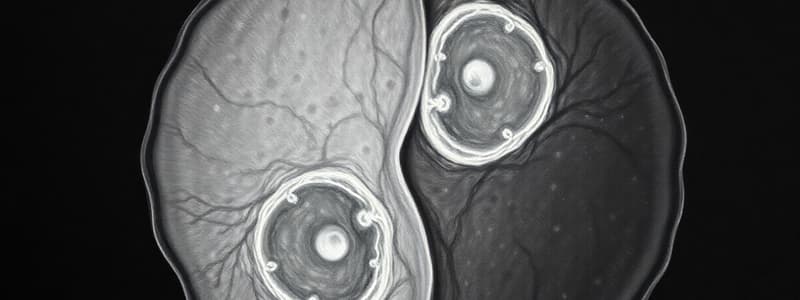Podcast
Questions and Answers
Which of the following events is unique to meiosis, as opposed to mitosis?
Which of the following events is unique to meiosis, as opposed to mitosis?
- Formation of the spindle apparatus
- Synapsis of homologous chromosomes (correct)
- Separation of sister chromatids
- DNA replication before cell division
Nondisjunction during meiosis can result in gametes with an abnormal number of chromosomes. If nondisjunction occurs during meiosis II, what is the likely outcome?
Nondisjunction during meiosis can result in gametes with an abnormal number of chromosomes. If nondisjunction occurs during meiosis II, what is the likely outcome?
- Two gametes will be normal, one will have an extra chromosome, and one will be missing a chromosome.
- No gametes will be aneuploid.
- All gametes will be aneuploid.
- One gamete will have an extra chromosome, and one will be missing a chromosome; the other two will be normal. (correct)
A human karyotype shows 47 chromosomes with an extra copy of chromosome 21. Which genetic disorder is indicated by this karyotype?
A human karyotype shows 47 chromosomes with an extra copy of chromosome 21. Which genetic disorder is indicated by this karyotype?
- Edwards syndrome
- Turner syndrome
- Klinefelter syndrome
- Down syndrome (correct)
Which type of chromosomal mutation involves the movement of a segment of a chromosome to a nonhomologous chromosome?
Which type of chromosomal mutation involves the movement of a segment of a chromosome to a nonhomologous chromosome?
During which phase of mitosis are the chromosomes aligned along the metaphase plate?
During which phase of mitosis are the chromosomes aligned along the metaphase plate?
A cell with a diploid number of 2n = 46 undergoes mitosis. How many chromosomes will each daughter cell have?
A cell with a diploid number of 2n = 46 undergoes mitosis. How many chromosomes will each daughter cell have?
What is the primary difference between active transport and passive transport mechanisms?
What is the primary difference between active transport and passive transport mechanisms?
Which of the following is an example of a chromosomal deletion?
Which of the following is an example of a chromosomal deletion?
How does facilitated diffusion differ from simple diffusion?
How does facilitated diffusion differ from simple diffusion?
Why are individuals with aneuploidy often affected by multiple phenotypic effects?
Why are individuals with aneuploidy often affected by multiple phenotypic effects?
Flashcards
Mitosis
Mitosis
Cell division resulting in two identical daughter cells; crucial for growth, repair, and asexual reproduction.
Meiosis Disorders
Meiosis Disorders
Errors during meiosis causing conditions like Down syndrome (trisomy 21) or Turner syndrome (monosomy X).
Chromosomal mutation
Chromosomal mutation
Changes in chromosome structure or number, including deletions, duplications, inversions, or translocations.
Transport Mechanism
Transport Mechanism
Signup and view all the flashcards
Study Notes
- Mitosis is a type of cell division that results in two daughter cells each having the same number and kind of chromosomes as the parent nucleus, typical of ordinary tissue growth.
Phases of Mitosis
- Prophase: Chromosomes condense and become visible, the nuclear envelope breaks down, and the spindle apparatus forms.
- Metaphase: Chromosomes line up along the metaphase plate (the equator of the cell), attached to spindle fibers.
- Anaphase: Sister chromatids separate and move to opposite poles of the cell.
- Telophase: Chromosomes arrive at the poles, the nuclear envelope reforms, and chromosomes decondense.
- Cytokinesis: The division of the cytoplasm to form two separate cells.
Significance of Mitosis
- Growth: Increases the number of cells in an organism, allowing it to grow.
- Repair: Replaces damaged or dead cells.
- Asexual Reproduction: In some organisms, mitosis is the basis of asexual reproduction.
Meiosis
- Meiosis is a type of cell division that results in four daughter cells each with half the number of chromosomes of the parent cell, as in the production of gametes and plant spores.
Phases of Meiosis
- Meiosis I:
- Prophase I: Chromosomes condense, homologous chromosomes pair up (synapsis) to form tetrads, crossing over occurs.
- Metaphase I: Tetrads line up along the metaphase plate.
- Anaphase I: Homologous chromosomes separate and move to opposite poles. Sister chromatids remain attached.
- Telophase I: Chromosomes arrive at the poles, the cell divides (cytokinesis), resulting in two haploid cells.
- Meiosis II:
- Prophase II: Chromosomes condense.
- Metaphase II: Chromosomes line up along the metaphase plate.
- Anaphase II: Sister chromatids separate and move to opposite poles.
- Telophase II: Chromosomes arrive at the poles, the cell divides (cytokinesis), resulting in four haploid cells.
Significance of Meiosis
- Genetic Diversity: Crossing over and independent assortment during meiosis increase genetic diversity.
- Sexual Reproduction: Meiosis produces haploid gametes, which fuse during fertilization to restore the diploid chromosome number.
Meiosis Disorders
- Nondisjunction: The failure of chromosomes or sister chromatids to separate properly during cell division.
- Can occur during Meiosis I or Meiosis II.
- Results in gametes with an abnormal number of chromosomes (aneuploidy).
Common Meiosis Disorders
- Down Syndrome (Trisomy 21): An extra copy of chromosome 21.
- Turner Syndrome (Monosomy X): Females have only one X chromosome.
- Klinefelter Syndrome (XXY): Males have an extra X chromosome.
Chromosomal Mutation
- Changes in the structure or number of chromosomes.
Types of Chromosomal Mutations
- Deletion: Loss of a portion of a chromosome.
- Duplication: Repetition of a portion of a chromosome.
- Inversion: A segment of a chromosome is reversed end to end.
- Translocation: A segment of one chromosome moves to a non-homologous chromosome.
- Nondisjunction: Results in aneuploidy (abnormal number of chromosomes).
- Monosomy: Loss of a chromosome (2n-1).
- Trisomy: Gain of a chromosome (2n+1).
- Polyploidy: Having more than two complete sets of chromosomes (e.g., 3n, 4n).
Causes of Chromosomal Mutations
- Errors during meiosis (nondisjunction, translocation).
- Exposure to mutagens (radiation, chemicals).
Transport Mechanism
- Processes that move substances across cell membranes.
Types of Transport
- Passive Transport: Does not require energy.
- Diffusion: Movement of molecules from an area of higher concentration to an area of lower concentration.
- Facilitated Diffusion: Movement of molecules across a membrane with the help of transport proteins.
- Channel proteins: Form pores or channels in the membrane.
- Carrier proteins: Bind to molecules and change shape to shuttle them across the membrane.
- Osmosis: Movement of water across a semipermeable membrane from an area of higher water concentration (lower solute concentration) to an area of lower water concentration (higher solute concentration).
- Active Transport: Requires energy (ATP).
- Primary Active Transport: Uses ATP directly to move molecules against their concentration gradient.
- Example: Sodium-potassium pump.
- Secondary Active Transport: Uses the energy stored in an electrochemical gradient (established by primary active transport) to move other molecules against their concentration gradient.
- Symport: Two molecules move in the same direction.
- Antiport: Two molecules move in opposite directions.
- Primary Active Transport: Uses ATP directly to move molecules against their concentration gradient.
- Bulk Transport: For large molecules or large quantities of substances.
- Endocytosis: Movement of substances into the cell.
- Phagocytosis: "Cell eating" - engulfing large particles or cells.
- Pinocytosis: "Cell drinking" - engulfing extracellular fluid.
- Receptor-mediated endocytosis: Specific molecules bind to receptors on the cell surface, triggering endocytosis.
- Exocytosis: Movement of substances out of the cell.
- Vesicles fuse with the plasma membrane, releasing their contents outside the cell.
- Endocytosis: Movement of substances into the cell.
Tonicity
- The ability of a surrounding solution to cause a cell to gain or lose water.
- Isotonic: Solute concentration is the same inside and outside the cell; no net water movement.
- Hypertonic: Solute concentration is higher outside the cell; water moves out, cell shrinks.
- Hypotonic: Solute concentration is lower outside the cell; water moves in, cell swells and may burst.
Studying That Suits You
Use AI to generate personalized quizzes and flashcards to suit your learning preferences.




